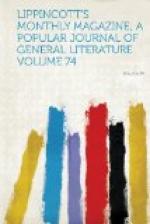In all the ages since Hamlet was created there appears never to have been an era in which his character has excited such strong and universal interest as in America at this time. William Hunt has thrown upon the canvas a figure of Hamlet beautiful and living. There is no suggestion of any actor in it. Hamlet walks new-born from the painter’s brain. His “cursed spite” bends the youthful shoulders, and the figure marches past unmindful of terrestrial presences.
One other picture will illustrate more clearly, perhaps, than everything which has gone before, this gift of imagination. In “The Boy and the Butterfly,” now on the walls of the Century Club-house, the loveliness of the child, the power of action, the subtle management of color and light, are all subordinated to the ideas of defeat and endeavor. Energy, the irrepressible strength of the spirit upheld by a divine light of indestructible youth, shines out from the canvas. The boy who cannot catch the butterfly is transmuted as we stand into the Soul of Beauty reaching out in vain for satisfaction, and ready to follow its aspiration to another sphere.
OUR MONTHLY GOSSIP.
WILHELMINE VON HILLERN.
German literature, despite its extraordinary productiveness and its possession of a few great masterpieces, is far from being rich in the department of belles-lettres, especially in works of fiction. It has no list of novelists like those which include such names as Fielding, Scott and Thackeray, Balzac, Hugo and Sand. In fact, there is scarcely an instance of a male writer in Germany who has devoted himself exclusively to this branch of literature, and has won high distinction in it. It has been cultivated with success chiefly by a few writers of the other sex, whose delineations have gained a popularity in America only less than that which they enjoy at home—in part because the life which they depict has closer internal analogies to our own than to that of England or of France, still more perhaps because the pictures themselves, whatever their intrinsic fidelity, are suffused with a romantic glow which has long since faded from those of the thoroughly realistic art now dominant in the two latter countries.
In none of them is this characteristic more apparent than in the works of Wilhelmine von Hillern, which bear also in a marked degree the stamp of a mind at once vigorous and sympathetic, and are thus calculated to awaken the interest of readers in regard to the author’s personal history.
Her father, Doctor Christian Birch, a Dane by birth and originally a diplomatist by profession, held for many years the post of secretary of legation at London and Paris. He withdrew from this career on the occasion of his marriage with a German lady connected with the stage in the triple capacity of author, manager and actress. Madame Birch-Pfeiffer, as she is commonly called, was one of the celebrities of her




